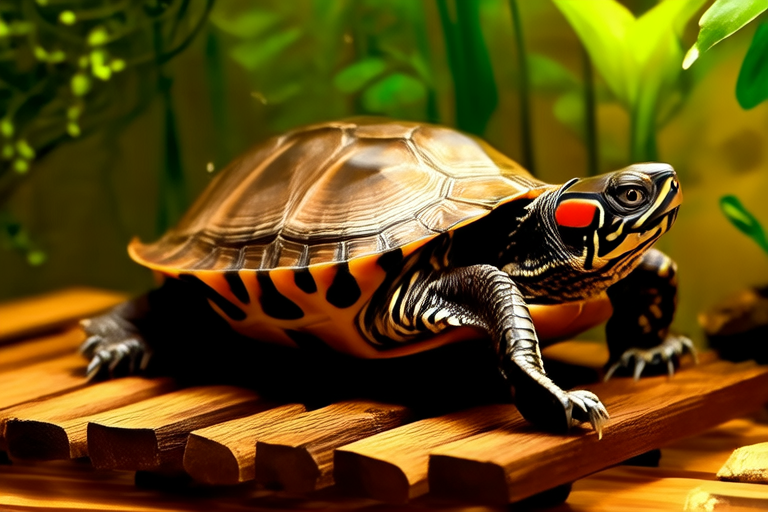Red-eared Slider Care Made Easy: Tips from Expert Turtle Owners
Welcome to your ultimate guide to caring for red-eared sliders! Whether you’re a first-time owner or an experienced turtle enthusiast, this comprehensive article will provide you with all the essential information you need to keep your pet happy and healthy. From setting up the perfect habitat to maintaining their diet and health, we’ve got you covered. Let’s dive into the world of red-eared slider care.
Habitat Setup: Creating a Comfortable Home for Your Turtle
Setting up the right habitat is crucial for the well-being of your red-eared slider. Here’s how to create a safe and comfortable environment:
- Tank Size: Red-eared sliders require ample space to swim and bask. A general rule of thumb is 10 gallons of water per inch of shell length. For an adult slider, a tank of at least 55 gallons is recommended.
- Water Filtration: Invest in a high-quality filter to maintain clean water. Regular water changes are also necessary to keep the water fresh.
- Basking Area: Provide a dry area where your turtle can fully emerge from the water to bask under a UVB light. This helps them regulate their body temperature and absorb calcium.
- Heating: Maintain the water temperature between 75-80°F (24-27°C) and the basking area around 90-95°F (32-35°C).
- Lighting: Install a UVB lamp that provides 10-12 hours of daily exposure. This simulates natural sunlight and aids in vitamin D synthesis.

Diet Guidelines: What to Feed Your Red-Eared Slider
Proper nutrition is key to keeping your red-eared slider healthy. Here’s what they need:
- Commercial Pellets: High-quality commercial pellets form the base of their diet. Look for products specifically designed for aquatic turtles.
- Variety of Vegetables: Offer leafy greens like romaine lettuce, collard greens, and dandelion greens. Avoid iceberg lettuce as it lacks nutrients.
- Fruits: Occasionally, offer small amounts of fruits like strawberries or blueberries. However, fruits should not be a significant part of their diet due to their high sugar content.
- Protein Sources: Include protein-rich foods such as earthworms, crickets, and occasional feeder fish. Be cautious with live food, as it may carry parasites.
- Calcium Supplementation: Dust their food with a reptile calcium supplement to ensure proper shell development.

Health Maintenance: Keeping Your Turtle Happy and Healthy
Regular health checks and preventative measures can help keep your red-eared slider in top condition:
- Regular Check-ups: Schedule annual visits to a veterinarian who specializes in reptiles.
- Shell Health: Inspect the shell regularly for any signs of soft spots, discoloration, or irregularities.
- Respiratory Issues: Watch for signs of respiratory infections, such as nasal discharge or difficulty breathing. Seek immediate veterinary attention if noticed.
- Parasites: Keep an eye out for external parasites like ticks or mites. Consult a vet for treatment options.
- Vaccinations: While vaccines aren’t typically required for turtles, discuss any necessary preventative measures with your vet.

Common Mistakes to Avoid: Pitfalls to Steer Clear Of
Avoid these common mistakes to ensure your turtle thrives:
- Overfeeding: Feeding too much can lead to obesity and other health issues. Stick to a balanced diet and portion control.
- Inadequate Lighting: Lack of UVB lighting can cause metabolic bone disease, leading to weak bones and shells.
- Poor Water Quality: Neglecting water quality can result in bacterial infections and other health problems. Clean the tank regularly and use a filter.
- Insufficient Basking: Not providing enough time to bask can disrupt their metabolism and calcium absorption.
- Improper Handling: Handle your turtle gently and infrequently. Frequent handling can stress them and lead to health issues.
Interactive Q&A: Insights from Experienced Turtle Owners
We reached out to some experienced turtle owners to share their advice and answers to common questions:
Q: How often should I change the water?
A: Change about 20-30% of the water weekly, and perform a full water change every 4-6 weeks. Always use a dechlorinator to remove harmful chemicals.Q: Can I keep multiple turtles together?
A: Yes, but ensure each additional turtle has adequate space. A good rule is to add 10 gallons of water per additional inch of shell length.Q: What should I do if my turtle isn’t eating?
A: First, check the water and basking temperatures. If they are correct, try offering different types of food. If the issue persists, consult a vet.Q: How long do red-eared sliders live?
A: With proper care, red-eared sliders can live 20-40 years or more.

Conclusion: Enjoying the Journey with Your Red-Eared Slider
Caring for a red-eared slider is a rewarding experience that brings joy and companionship. By following the tips outlined in this guide, you’ll ensure your turtle lives a long, healthy, and happy life. Remember, every turtle is unique, so pay close attention to their individual needs and behaviors. Happy turtle keeping!
